Midweek Review
Brecht’s Chalk Circle Again and Again
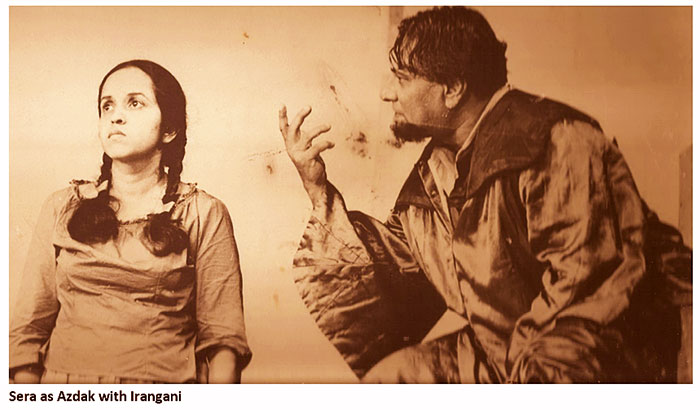
Azdak’s Judgments:
by Laleen Jayamanne
Soldier: Your Honour, we meant no harm. Your Honour, what do you wish?
Azdak: Nothing, fellow dogs. Or just an occasional boot to lick!
[…]
Fetch me wine, red wine, sweet red wine.
‘In a faraway and long-ago, dark and bloody epoch, in a sunburnt and cursed city, there lived a Duke…’ sang the storyteller. In the mid-’60s when Brecht’s Caucasian Chalk Circle was first performed there, Colombo had ceased being dark and bloody. April ‘71 was yet a few years away. But the effects of the Sinhala Only Act of ‘56 were taking root in educational institutions, like the National School of Art and Crafts, creating a myopic, monolingual culture. In this context, Henry Jayasena and others in the Sinhala theatre who were interested in developing contemporary drama, began to translate modern European plays, originally written in German, Russian and Italian. Crucially, these Sinhala versions were drawn from English translations of the original languages of the plays. So English worked as the essential ‘link’ language without which we would not have had any access to world theatre and much else. Henry had a good command of English, learnt in high school and at Teachers’ College. Like his similarly brilliant contemporary Sugathapala de Silva, he was not a University educated artist. But Jayasena’s superb theatrical imagination allowed him to translate from English the Chalk Circle into a most wonderful colloquial poetic Sinhala idiom. So much so that it feels like the play was written originally in Sinhala! Reading the Sinhala script was a pleasure in itself and sections have remained in my old brain, as good poetry does. The epic techniques of supple shifts from the songs of the narrator, to the every-day racy, bawdy dialogue of the soldiers, to the lyrical love passages between Grusha and Simon Shashava, to the absurdist folk utterances of Azdak, are all memorably crafted and differentiated.
Bertolt Brecht’s Epic play written in 1944 while he was in exile in the US, fleeing Hitler’s fascist Germany, continues to be a vibrant part of Lanka’s living ‘theatrical epic-memory’. Also, as a text for the O’Level, a large number of Lankans must have become familiar with it. The play has a ‘play-within-a-play’ double structure but in scene 4, Azdak’s story, there is a further third level. That is, a ‘play-within-a play-within-a play’. The first play is set in the present postwar Soviet Republic of Georgia in 1945, where workers of two Collective Farms meet with a State official to decide, through discussion, as to who should have the stewardship of a particular valley. The Farmers who have been in the valley since birth claim it as their own for their goats to graze in, while the other group say that through irrigation they can make the valley more productive of fruit and wine. Its key question is, ‘who is good for the land?’
The play-within the play, set in the Imperial past of a fictional Georgia or Grusinia, at war with Persia. The folk parable of the Chalk Circle is performed as entertainment after the debate about the valley has been reasonably decided. The key question there becomes, ‘who is the good mother for the child?’ – (hadu mavada, vadu mavada? The third level of a play-within a play-within a play is a mock trial between a prince who wants to be the Judge and Azdak pretending to be the deposed Grand Duke, as the defendant. In all there are six or seven judgments that involve Azdak in one way or another. The intricacies of each of these legal cases and their differences from each other, make scene 4 a most fascinating aspect of the episodic structure of the play itself. In contrast, scenes 1-3 involving Grusha the kitchen-hand and her dilemma are expressed memorably and clearly by the narrator: “Terrible is the temptation to be good.” This is Grusha’s decision to save and nurture the Governor’s abandoned infant, without counting the terrible cost to herself. Her scenes, engaging as they are, do not have the kind of intricacy and complexity of the six or so episodes where Azdak plays with several ideas of Law and of Justice.
Animals’ Rights and the Folk Imagination
An Epic Contest is staged in the play, between the idea of The Law as a written code by absolutist rulers, and ideas of Social Justice, which include a sense of fairness towards the poor and powerless. This ample human feeling of fairness is encoded in folk tales of peoples across Eurasia where animals also have a claim on Justice from humans. For example, the Mahavamsa tells us of the remarkable sense of justice embodied by the Tamil King Elara when he ruled Anuradhapura. He had a bell hung at his palace gate, which anyone could ring to make a claim when an injustice had been committed. So, when a cow complained to Elara that his son in his chariot had run over and killed her calf, he did not hesitate to put his son to death. We are told that taking pity on them, both lives were restored by a god. According to my friend Amrit MacIntyre who is a lawyer and legal scholar that story is found in various forms in the Middle East to Europe. Each version of the story is about a king from the distant past who is known for his justice. Critically, in each version the person seeking justice was an animal, a serpent in Italy seeking justice from Charlemagne, and an ass in the Middle East seeking justice from an Iranian Emperor (Khusro I). What is intriguing in all of this is a common conception of justice equally applying to all, including animals, that forms part of the mental landscape across Eurasia from very early on. Interestingly, a 2017 decision of the Supreme Court of India referred to the story of Elara as part of its reasoning! The folk tale of the Chalk Circle is found in an ancient Chinese play, as well as in the Judgment of Solomon in the Old Testament, and both were points of reference for Brecht in radically rewriting the tale as a modern epic parable influenced by Marxist ideas.
Azdak, the town scribe and rogue judge, was played memorably by Winston Serasinghe in Ernest MacIntyre’s English production. Henry Jayasena played the same in his own production, also in the mid-60s. And MacIntyre also acted as the priest in Henry’s production – one of the earliest exchanges between English and Sinhala Theatre in the ‘60s. That is to say, between the Lionel Wendt and Lumbini theatres, respectively. Azdak was the village scribe who, when the State collapsed and the official judge hanged by the rebellious carpet weavers, was forcibly roped in to act as a judge by the illiterate soldiers. But it turned out that he had his own eccentric ideas of Justice and fair play and was a bit drunk, sexist and openly took money from plaintiffs. Though Azdak appears only in the last 2 scenes, he leaves a powerful impression in one’s memory as a character like Shakespeare’s Falstaff. But he is unlike Falstaff whose fall from grace, after rejection by his former buddy Prince Hal, is full of tragic pathos. Azdak is a creature of the folk imagination.
Epic-Character Azdak
Sumathy Sivamohan concludes her recent article on the links between the two Republican Constitutions of Sri Lanka (‘72 & ‘78), by invoking Azdak as a figure relevant to this moment of the People’s Aragalaya, (The Island 8/8). Azdak is a Brechtian Epic-Character through whom the very ideas of Law and Justice are examined, played with, debated and put into crisis, theatrically. He is also a great comic figure introducing laughter into the court where it is thought to be unseemly. In this way Brecht’s Epic Theatrical practice offers us several unusual angles on the process of making Judgements, the reasoning behind them. Through these scenes, the idea of Justice appears paradoxical, not altogether just in one case, but also both reasonable and yet ‘unlawful’, if judged according to the letter of the Law, in another. And some downright absurd. This complexity, of plot lines and intricacy of comic procedural ‘legal’ detail, is significant in demonstrating the class basis of judgements and how they are reached. The hilarious comic absurdity of some of Azdak’s arguments and rulings parody seemingly rational, legalistic linguistic power-play in regular courts. ‘Demonstrability’ is a strong concept in Brechtian theatrical theory and is linked to the idea of the pedagogical function of Epic Theatre.
A Brechtian Parable for the Aragalaya?
The comedic demonstration of the interplay between the Law and Justice, appears to be relevant to Lankans now, poised in their struggle to make politicians accountable for their actions which have plunged the country into economic, political and existential chaos. Azdak is an epic construct and as such we don’t quite empathise with him or like or dislike him. Rather, we observe this comic figure with enjoyment, as he plays with a variety of judgments, with no rule book as guide. He excites our curiosity about the mechanics of the Law, its different avatars, (Totalitarian Law, People’s Law, a judgment without a precedent), which, in an Imperial regime, as in the world of the play within the play, seems invincible and arbitrary. The two lawyers of the Governor’s wife Natella Abashvili are, however, immediately recognisable social types aligned with social power, contrasting with Azdak’s Epic singularity. They argue for the right of the blood-line to obtain the child from Grusha, to return to his biological but callous and predatory mother, only so that she can claim the property bequeathed to the child.
A Palace Revolution
The Chalk Circle opens on a seemingly normal Easter Sunday, with the wealthy Governor and family attending church to great fanfare that soon turns violent – palace revolution creates chaos and soldiers go to war against distant Persia. The Governor is beheaded, his head impaled on a lance and displayed, nailed to a wall, while his wife flees forgetting to take their baby. The Grand Duke has also gone into hiding. The Carpet Weavers, taking advantage of the revolt, hang the Judge. So it comes to pass that the village scribe Azdak becomes the accidental Judge, under a state of emergency. Not knowing the Law is no impediment to Azdak. Some of these events and scenes of the play have an uncanny resemblance to the farcical misrule seen in the Lankan Parliament not too long ago. Before we look at Azdak’s celebrated Judgments it’s worth looking at Brecht’s original theatrical structure, which is Epic rather than Dramatic.
Epic Theatre vs Tragic Drama
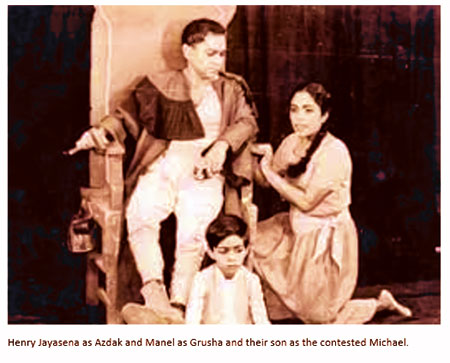 Brecht’s play is not a tragedy, a genre he rejected as an Aristotelian Greek notion driven by an idea of Destiny and causality and heroic action. The presence of a singer-narrator who introduces us to the play is an epic device in that, as the story-teller, he conducts the action. He stops characters in their tracks and sings of what they feel, but cannot say. He explains the action when necessary and advances the story. The famous singer who knows twenty-one thousand lines of verse becomes the story-teller. He announces that the play consists of ‘two stories and will take two hours to perform’. The Soviet expert from the city is impatient and asks him, (after the disagreement between the two collective farmers is resolved), “can’t you make it shorter?” The singer responds with a firm ‘No’. Brecht offers a play, which is profoundly episodic in its construction. Each episode is autonomous, has a relative freedom from a tight causally driven dramatic structure. What Brecht wanted was a theatrical structure which didn’t have any inevitable causal links propelling events as in the case of, say, Oedipus Rex. In this way he demonstrates how History and its presentation in the Epic, hold alternative possibilities. The Epic form can reveal in its episodic structure ‘the many roads not taken’. Some academics in the Aragalaya have begun to examine Lanka’s post independent history and the many roads not taken in structuring the economy, in race relations and education and development policy, for instance.
Brecht’s play is not a tragedy, a genre he rejected as an Aristotelian Greek notion driven by an idea of Destiny and causality and heroic action. The presence of a singer-narrator who introduces us to the play is an epic device in that, as the story-teller, he conducts the action. He stops characters in their tracks and sings of what they feel, but cannot say. He explains the action when necessary and advances the story. The famous singer who knows twenty-one thousand lines of verse becomes the story-teller. He announces that the play consists of ‘two stories and will take two hours to perform’. The Soviet expert from the city is impatient and asks him, (after the disagreement between the two collective farmers is resolved), “can’t you make it shorter?” The singer responds with a firm ‘No’. Brecht offers a play, which is profoundly episodic in its construction. Each episode is autonomous, has a relative freedom from a tight causally driven dramatic structure. What Brecht wanted was a theatrical structure which didn’t have any inevitable causal links propelling events as in the case of, say, Oedipus Rex. In this way he demonstrates how History and its presentation in the Epic, hold alternative possibilities. The Epic form can reveal in its episodic structure ‘the many roads not taken’. Some academics in the Aragalaya have begun to examine Lanka’s post independent history and the many roads not taken in structuring the economy, in race relations and education and development policy, for instance.
Azdak’s Judgements
Why do I think that a ‘close reading’ of Azdak’s judgements matter, especially now? Because he has a window of opportunity during a palace revolution, to play with and interrogate ideas of Law and Justice. It is quite by chance that he is made a judge because the official judge has been hanged, the Governor executed and the Duke has fled during the civil war. Now is a time when a large number of people in Lanka are feeling that the Laws that govern them and their sense of Justice are at variance. And Azdak’s idiosyncratic process of judging and his rulings offer several unusual angles on both. He is unprincipled and we can’t tell which way his Judgment will fall, regardless of his own precedent. He is inconsistent but not amoral, he shows feelings on the bench, he is not ‘Blind Justice’. He has a strong conscience. Guilt-ridden, he has himself arrested and shackled by Sauwa the cop, for having unwittingly given the fugitive Grand Duke refuge in his hut and helped him escape, during the palace revolution.
In the mock trial Azdak impersonates the Grand Duke. The soldiers who call the shots say they want to test if the Nephew is fit and proper to be a judge as recommended by his uncle Prince Kazbeki. So they create a legal play within the play by making Azdak play the role of the Grand Duke as the defendant and the Nephew the acting judge. Azdak as the Grand Duke is accused of losing the war and in his comic defense he demonstrates how the Princes actually won by war-profiteering and enabling the Persians victory. All this is done in a brilliant quick-witted, punchy question and answer session where Azdak twists words and wins the argument with relish. Proven guilty of embezzlement, the soldiers arrest the acting judge and Prince Kazbeki and plonk Azdak on the throne, unceremoniously throwing the cloak of the dead judge across his shoulders. It’s high farce with linguistic fireworks in court.
A judgement Azdak makes from the bench deals with a farmer’s complaint against his farmhand who is accused of raping his daughter-in-law, Ludovica. By contemporary feminist standards Azdak’s judgment that Ludovica by virtue of her seductive walk, seduced and thereby ‘raped’ the man, is idiotic and sexist. But the scene is more ambiguous. It might be the case that what was called rape by the father-in-law may have been consensual sex, which he happened to stumble in on. We are told by the narrator that the Ludovica’s speech was well rehearsed. The scene remains ambiguous, open to several readings especially because Azdak orders Ludovica to accompany him to examine the scene of the crime after the verdict has found her guilty! The narrator has called him, ‘Good judge, bad judge, Azdak.’
Another judgment shows that Azdak is indeed a ‘people’s judge,’ ruling in favour of a grandmotherly old woman, against the three farmers who accuse her of theft. The old woman wins the case by virtue of being poor, despite the fact that the items were stolen on her behalf by a relative who is a Bandit. The plea she offers in her defense is her belief in miracles. So, taking up her cue Azdak reprimands the Farmers for not believing in miracles! To save time, Azdak decides to hear two similar cases of professional negligence and blackmail, together!
The judgment of the Chalk Circle is what Azdak is most famous for. But the previous ones, with their pileup of parodic absurdity, are crucial for Brecht’s politics in Demonstrating how social class, wealth and power determine legal ritual. Once the normality of the Grand Duke’s authoritarian rule is restored, Prince Kazbeki is beheaded as a traitor. The chaos of the revolutionary moment (‘a Golden age’?) that saw Azdak become a judge, with his own unique sense of justice, is reversed with the return of the Grand Duke. He is now attacked by the illiterate soldiers, bloodied and humiliated, soon to be hanged. But at the last moment a messenger from the Grand Duke arrives with a document ordering Azdak to be exonerated and made judge for having saved the Duke’s life. It is jarring to register that the Grand Duke does have a sense of aristocratic honour (unlike Lanka’s rulers) despite his reputation as a swindler and butcher.
Azdak wipes the blood from his eyes as he finds himself plonked on the judges’ chair yet again, and makes the celebrated progressive modern judgment of the Chalk Circle. It is reached through an ingenious process based on an ancient wordless contest. Grusha repeatedly refuses to pull the child out of the circle lest he be injured and so she is deemed the ‘true’ mother and given custody of the child, against the predatory biological mother who pulls him out. The singer then concludes the epic parable with a poetic summary of how Azdak aligned a feeling of Justice with eminently reasonable new rules. In that legal thinking, human emotion becomes the sister of rational thought.
Singer:
“The people of Georgia
Remembered him, and remembered
For a long time,
The times when he was judge
As a short, golden age
When there was justice – nearly.
Take to heart,
All you who’ve heard
The Tale of the Chalk Circle
And what that ancient song means.
What there is should belong
To those who are good at it.
Children to true mothers,
That they may thrive.
Carts to the good drivers,
That they may be driven well,
And the valley to the waterers,
So that it bears fruit.”
Sri Lanka is a country in which Chalk Circle has been seen and enjoyed for generations. Doing a close reading of the play, while following the non-violent political uprising and struggle of the people from afar, gives one hope that changes good for Lanka are imaginable so that the land may bear fruit.
Features
AKD faces challenging year ahead
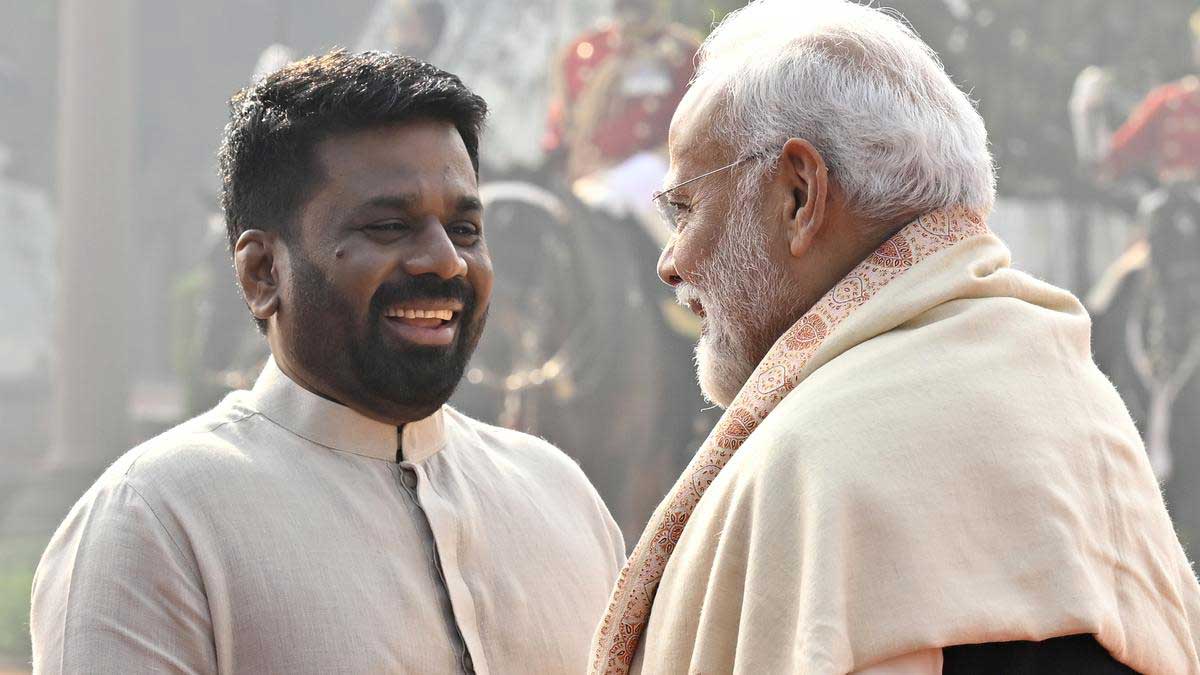
By Shamindra Ferdinando
Senior lecturer in economics and head of the IT Department at the University of Colombo, Professor Priyanga Dunusinghe, recently declared that the new National People’s Power (NPP) administration had neither a clear economic policy nor a tangible action plan to address the plethora of serious issues facing the nation.
Prof. Dunusinghe warned of dire consequences unless the government took meaningful measures to overcome the challenges.
Appearing on Derana, the outspoken academic claimed that the investors and the public were in the dark as to the overall government economic policy. Asserting that the NPP government now primarily addressed the day-to-day issues, Prof. Dunusinghe alleged that economic reforms required to stabilize, consolidate and strengthen the economy weren’t being implemented. Therefore, the government seemed to be already late in that regard.
Obviously Prof. Dunusinghe summed up the situation on the economic front quite accurately. The academic seemed to have contradicted former President and UNP leader Ranil Wickremesinghe who had both publicly and privately applauded President Anura Kumara Dissanayake’s economic policy recently. It could be a case of him wanting to appease NPP as he, too, has many a skeleton in his cupboard, like the bond scams or the precipitating of the ongoing debt crisis by borrowing as much as USD 12 billion from the international bond market, at high interest, without having achieved anything tangible to show with such high borrowings, all during the Yahapalana rule or misrule.
Readers should always remember Mahinda Rajapaksa and his team fought a debilitating war to a finish against the world’s most ruthless terrorist outfit, the LTTE, and defeated it against the predictions of all types of pundits, while at the same time kept the economy humming and completed some impressive infrastructure projects, like building a brand new international harbour and an airport, among so many other achievements. Need we say more?
No doubt there were some utter mistakes that can be directly attributed to some of his close relatives he had around him, but Mahinda never betrayed the country. For that matter, who is infallible in this world? The bottom line reveals only one thing that is, he was the best leader to pull the country out of the rut we were in at the time.
President Dissanayake also holds the Finance portfolio, in addition to Defence. In terms of the Economic Transformation Bill, approved by Parliament on July 25, 2024, without a vote, the NPP government has no option but to adhere to the Act. Prof. Anil Jayantha Fernando is the Deputy Finance Minister.
The agreement with the IMF, negotiated by Wickremesinghe and accepted by Dissanayake, in his capacity as the President, is the basis for the controversial Act. In spite of attacking the Economic Transformation Bill, the then Opposition conveniently refrained from seeking a vote on the Bill.
Prof. Dunusinghe has been always forthright in his criticism of questionable economic matters, regardless of who wielded the political power. The government should take such criticism seriously as the overall situation remained volatile though the parliamentary Opposition seems wholly inadequate and indifferent to the challenges ahead.
The pathetic and shoddy handling of severe shortage of rice in the open market badly exposed the government. What really surprised the hapless public is the NPP’s thinking the ‘Rice Mafia’ can be reined in by the issuance of gazettes. The NPP basically repeated President Gotabaya Rajapaksa’s strategy by declaring price controls on essential commodities, like rice, by issuing gazettes. The NPP placed Nadu, Samba and Keeri Samba at Rs 230, Rs 240 and Rs 260 respectively a couple of weeks ago, following talks with rice millers, but it didn’t make any difference.
During the debate over the failed bid to control the private sector running the show, as it pleases, it was revealed that one of the biggest rice dealers in the country and identified as one of those who had been accused of earning unconscionable profits at the expense of the suffering people is on the National List of the SJB though he didn’t get an opportunity to enter Parliament this time. How did he end up in the SJB National List?
The NPP appeared to be making the often repeated mistake committed by previous governments in believing in the strength of their parliamentary group. In the face of public anger caused by wrong decisions, very often even such monolithic parliamentary groups crumble under pressure. The NPP wouldn’t be an exception unless it quickly realized and addressed the shortcomings.
Real challenge outside Parliament
The situation in Parliament is deceiving. It may give the NPP a somewhat false sense of security. Having handsomely won the presidential election in Sept, 2024 by polling 5.7 mn votes, though he couldn’t obtain 50% plus 1 vote, Anura Kumara Dissanayake consolidated the NPP’s position with a staggering 2/3 majority at the parliamentary election in Nov, 2024.
The NPP increased its tally to 6.8 mn votes from 5.7 mn polled at the presidential. Both the executive and the legislature are in the NPP’s hands. The main Opposition Samagi Jana Balawegaya (SJB) has been reduced to just 40 seats against the NPP’s 159 and down to just 1.9 mn votes at the parliamentary election. The SJB performance is nothing but pathetic.
The dismal results at the national elections had made the Sri Lanka Podujana Peramuna (SLPP) that obtained a staggering 145 seats at the 2020 general election irrelevant with their tally reduced to just three seats in the current Parliament.
But, the NPP cannot be lulled into a false sense of security, under any circumstances, as the real challenge is not the Opposition but the promises made by the party to the masses for a system change in the run-up to the presidential and parliamentary elections. That is the undeniable truth. Having come to power as an all-knowing lot, the NPP leadership will have to answer for developments, come what may.
The recent declaration that those earning a monthly salary up to Rs. 150,000 would be exempted from the PAYE (Pay As You Earn) tax to please professionals and at the same time announced the increasing of the withholding tax on fixed deposit interest to 10 percent from 5 percent, thereby hitting those living on already depleted interest incomes below the belt, underscored the crisis the country is in.
President Dissanayake, in his capacity as the Finance Minister, told Parliament on Dec. 18 that this was done in line with a fresh agreement reached with the IMF. In other words, in spite of the change of government and their severe criticism of Wickremesinghe’s policies, the NPP is also on the same track.
The bottom line is that Sri Lanka’s economic direction is firmly in the hands of the IMF and whatever the NPP leaders uttered to the contrary from election platforms to impress the public in the run up to national elections, the government will have to toe the IMF line when it presents a formal Budget in February for the next financial year.
An interim Budget/vote on account covering the first four months of 2025 was approved in Parliament on Dec. 06, 2024 without a vote, at the end of a two-day debate.
Deputy Finance Minister Fernando told Parliament that the delay in debt restructuring, over the last two years, had cost the country an additional USD 1.7 billion in accumulated interest.
Fernando is on record as having said: “We are hoping to complete the restructure of the bilateral debt and international sovereign bonds by December 31.”
The interim Budget would cover the cost of debt servicing and the government expenditure for the first four months of next year. The NPP government has assured the international community that it would continue to honour the international commitments on debt restructuring commenced by the predecessor Wickremesinghe’s government.
Ground realities
During the presidential election campaign followed by the general election, the NPP talked as if it could address issues that plagued Sri Lanka over the past decades. However, over three months after the presidential election, the public now realize that the NPP had no magic wand in its hand and some issues can never be settled.
Of course, some of those who exercised their franchise in support of the NPP at the two national elections are deeply worried and disappointed. But, the fact remains that those who exercised political power had been appropriately dealt with by the electorate and they wouldn’t be in a position to regain public confidence within a short period. That is the reality those who represent the SJB and NDF (National Democratic Front) had to contend with.
It would be pertinent to mention that two of the oldest political parties in the country, namely the UNP and the SLFP, are not even represented in the current Parliament. The UNP and SLFP leaderships are baffled, but that wouldn’t make things easy for the NPP, regardless of its numerical unconquerable position in Parliament. So did the previous Gotabaya Rajapaksa government that was ousted by violent street protests, most probably staged managed from abroad.
Let me briefly discuss the huge challenge faced by Sri Lanka in dealing with large scale poaching carried out relentlessly by the Tamil Nadu fishing fleet in addition to them destroying fish stocks here by bottom trawling. The joint statement issued following talks between President Dissanayake and Indian Premier Narendra Modi quiet clearly indicated that New Delhi wants Sri Lanka to turn a blind eye to the ongoing rape of fishery resources belonging to the people here.
President Dissanayake raised the massive destruction caused by bottom trawling practised by the Tamil Nadu fishing fleet but the joint statement and the comments made by the Indian Foreign Secretary Vikram Misri on this issue at a special briefing indicated in no uncertain terms that India wouldn’t under any circumstances take necessary measures to prevent Tamil Nadu fishing fleet crossing Indo-Lanka maritime boundary.
India seemed to be hell-bent on allowing destructive fishing practices in Sri Lankan waters though it doesn’t allow the same in their territory.
India often emphasises the responsibility on the part of all concerned to deal with poachers in a humanitarian manner. The joint statement went a step further. Referring to the talks, Premier Modi had with President Dissanayake on Dec 16, 2024, the joint statement declared the two leaders ‘underscored the need to take measures to avoid any aggressive behaviour or violence. Would it be fair to pressure Sri Lanka, now beholden to New Delhi for swift economic assistance provided during 2022 and 2023 crisis period, to allow poaching?
How could there be a mutually acceptable solution to the poaching issue when the Indo-Lanka maritime boundary is being violated almost on a daily basis? Although the joint statement referred to the matter at hand as fisheries issues it is nothing but poaching sanctioned by the centre in India.
The joint statement, however, gave the game away when it asserted that the issue should be dealt with taking into consideration, what it called, the special relationship between India and Sri Lanka.
Hats off to President Dissanayake for taking up two related issues at a joint media briefing addressed by him and Premier Modi. A statement issued by the Presidential Media Division (PMD) quoted the NPP and JVP leader as having said that he requested Premier Modi to take measures to stop bottom trawling that caused irreparable ecological damage and also curb illegal, unreported and unregulated fishing (IUU fishing). President Dissanayake also reminded them that bottom trawling is banned in both countries. The President took up the position, therefore tangible action should be taken to stop bottom trawling.
But Indian Foreign Secretary’s response to Sachin Vadoliya of UNI query on President Dissanayake’s request pertaining to bottom trawling and IUU fishing revealed that New Delhi had no intention of addressing the issues at hand. The Foreign Secretary conveniently interpreted President Dissanayake’s comments as meaning the Sri Lankan leader calling for the problem to be solved by both countries together.
The supreme irony is that India exploited the situation to its advantage. The ongoing bid to formalize poaching by the Tamil Nadu fishing fleet under the pretext of some bilateral agreement cannot be condoned under any circumstances.
While declaring New Delhi’s immediate readiness to finalize what Premier Modi called a Security Cooperation Agreement, Sri Lanka is being asked to allow rape of its fish resource. The Illankai Thamil Arasu Kadchi (ITAK), the largest Tamil political party that represented the Northern and Eastern regions remained unsure of its stand on the fisheries issue.
The ITAK must take a clear stand on this problem. But, the NPP, having secured the highest number of seats in the Northern and Eastern regions at the expense of the ITAK at the recently concluded general election, needs to represent the interests of the Tamil fishing community here.
Resumption of debt repayment
The primary challenge faced by President Dissanayake is nothing but preparing the economy over the next four years to restart paying the massive foreign debt owed by the country in 2028. The government’s capacity to meet this particular challenge should be examined taking into consideration Prof. Dunusinghe’s criticism of the NPP’s economic plans.
Sri Lanka, in April 2022, made a unilateral statement on stopping debt repayment. Regardless of promises made during the presidential and parliamentary poll campaigns, the NPP is slow in taking tangible measures to revive the sick economy. The absence of long queues at fuel and gas stations doesn’t mean Sri Lanka is out of the woods yet.
Unfortunately, the Opposition is waiting for problems created by previous administrations to overwhelm the NPP. Having declared that the NPP administration couldn’t last for not more than a couple of months, the Opposition realized that their only salvation is the NPP causing its own downfall.
Perhaps, the NPP should reveal its stand on accusations that the failure on the part of the Parliament to amend the Foreign Exchange Act No 12 of 2017 that allowed unscrupulous people to park billions of US dollars overseas.
Various politicians have given different figures in this regard. Then MP Gevindu Cumaratunga estimated the total amount parked abroad owing the lacuna in the Act at USD 36 billion. His colleagues Wimal Weerawansa and Vasudeva Nanayakkara, too, agreed with the figure declared by Cumaratunga.
Former Justice Minister Dr. Wijeyadasa Rajapakse, PC, estimated the amount of funds parked overseas to be over USD 50 billion. Interestingly, he was among those who voted for repealing the old Act that ensured that exporters brought back export proceeds within a stipulated time period.
The Yahapalana administration repealed the time-tested Exchange Control Act of 1954 at the behest of the then Premier Ranil Wickremesinghe who refrained from voting for it.
The NPP never addressed this issue during campaigning. The NPP also owes the country an explanation as to why the price of a litre of 92 Octane couldn’t be further reduced as during the campaign the then Power and Energy Minister Kanchana Wijesekera was repeatedly accused of taking kickbacks at the expense of consumers.
So far, a litre of Octane 92 has been reduced to Rs 309 from 311 by the NPP. The government has also earned the wrath of the public for putting off the stipulated electricity price revision at a time much of the electricity is generated by hydro power stations at low cost.
The government seems caught in a vortex of problems-ranging from never ending problems faced by the farmers to Indian and US pressure to extend the moratorium on foreign research vessels visiting Sri Lankan ports. The moratorium declared by Wickremesinghe for a period of one year 2024 ended yesterday (Dec 31, 2024). Would it be extended, to allow Chinese vessels to resume visits or would some committee be appointed to take time to appease India, while Sri Lanka sought to reach some sort of understanding with China.
Features
Photography: A Primitive Theatre

BY Saumya Liyanage
(Text of a keynote address delivered at the annual Diploma Certificate Award Ceremony, organised by the National Photographic Art Society, Sri Lanka, on the 26 October 2024)
When a photograph of the main protagonist, Joseph, in the play Antique Kadayaka Maranayak (‘Death in an Antique Shop’), written and directed by Asoka Handagama, was shared on Facebook, a much awaited discussion erupted among theatregoers on how this image captured the true essence of the play. The playwright and director Handagama had also commented on Facebook, stating that the photographer, Sagara Lakmal de Mel, has captured the ‘full coverage of the play’ (Handagama, Facebook, 4th June 2023). This statement and the comments received for the Facebook post aroused a question of how photography links with theatre. How could a still image depict the essence of a play? Why is a still image of a play so important for us to understand the nature of acting, mise en scène, and other aspects of theatre?
Theatre photography has not been a major interest of the Sri Lankan photographers who capture the actors’ work on stage. It is very seldom that theatre productions are being captured by photographic documentation with a purpose of archiving and research. Photographers who are involved with theatre productions very often think of documenting theatre performances for the sake of documenting the “event” rather than systematically capturing the essence of the live performance. This paper therefore intends to explore the affinity between photography and theatre. Though these two art forms seem categorically different from each other, this short write-up attempts to suggest a convergence between these two art forms or, rather, sheds light on how these two art forms can be intermingled.
One of the fundamental questions that triggered my mind on photography is why photography is important for us to consider as a reflection of our own world and time. Some of the key features of photography include providing us with memories, preserving the past and our human and natural histories, capturing what we perceive as reality around us, and representing the lives of both humans and animals. Some experts say that photography captures time, memory, duration, presence, love, loss, mourning, and nostalgia. I am aware that photography is an industry. It is a commercial industry where people can make lots of money out of it. However, my question does not comply with the photographic industry but is directed towards the art of photography or the “ontological desire” of photography.
As an actor, I have been fascinated by the presence, absence, and the embodiment of meanings in images. In theatre arts, presence and absences are key elements in a live performance. As Peggy Phelan argues, ‘Performance’s only life is in the present […] The document of Performance […] is only a spur to memory, an encouragement of memory to become present’ (Phelan 1993, p. 146). The nature of live theatre is thus always ephemeral. But photography captures images and preserves them in a particular time and space. However, in terms of its presence and absence of images, photography shares the same phenomenological implications with theatre.
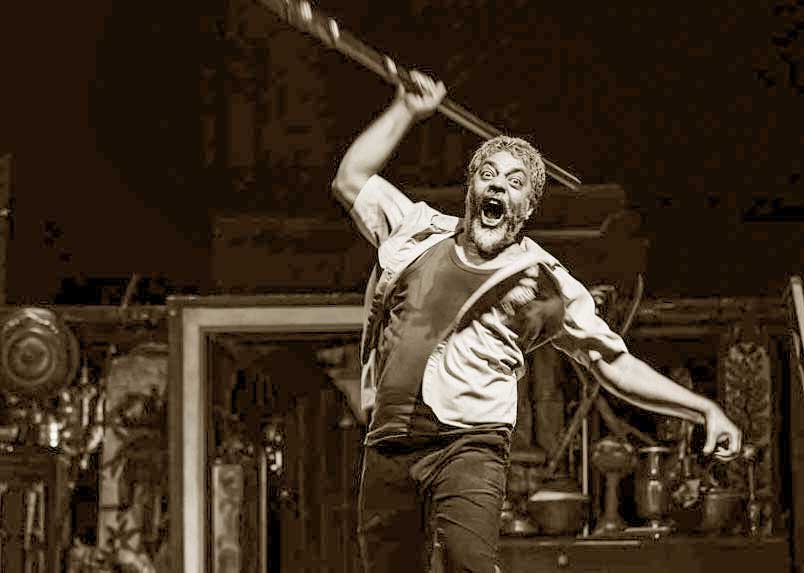
This image of Saumya Liyanage in the play Antique Kadayaka Maranayak (Death in an Antique Shop), shared on Facebook, provoked debate. Photo credit: Sagara Lakmal de Mel.
It is vital for me to emphasise the phenomenological implications of photography because the young generation of photographers should at least be aware of the breadth and depth of the art they use. As you may know, one of the classical writings on photography is Camera Lucida: Reflections on Photography, written by French philosopher and semiotician Roland Barthes. In this collection of essays, Barthes articulates his ideas on photography and shows us how the majority of theorists see resemblances between photography and paintings. However, Barthes argues that photography is more directly linked with theatre than visual art or painting. ‘Photography is a kind of primitive theatre, a kind of Tableau Vivant, (a tableau vivant is a static scene containing one or more actors or models), a figuration of the motionless and made-up face beneath which we see the dead’ (Barthes, 1993, pp. 31-32).
After watching Brecht’s play Mother Courage and Her Children in Paris, Barthes wrote an important paper titled ‘Seven Photo Models of Mother Courage.’ In this essay, Barthes had selected seven photographs taken during the staging of Mother Courage. During this performance, a photojournalist named ‘Pic’ had taken a series of photos using a telephoto lens that captured the vital moments of the play. Another essay written by Barthes titled “Diderot, Brecht, Eisenstein” (1973) further widened his discussion about the value of photography in analyzing mise en scène of the play.

German Actor, Helen Weigal’s ‘Silent scream’ in Mother Courage and Her Children by Bertolt Brecht. The image was captured by a photojournalist in 1957 when Berliner Ensemble staged the play for the second time in Paris.
Barthes argues that when studying Brecht’s plays, it is important to focus on the “Pregnant Moments” of the scenic situations. Photography as a medium of capturing these “Pregnant Moments” is vital to understanding the tableaux. ‘In so doing, photography would function as a technology for the recording of the tableaux created by the playwright /metteur-en-scène’ (Carmody, 1990, p. 31). When studying Brecht’s plays, this tableaux represents Brecht’s key concept of gestus (a gesture, or a set of gestures that can be read as a social demeanor of a character).
The idea of Tableau Vivant is vital for us to further understand how this still photograph is linked with theatre and its theatrical presence. Theatre is performed in a particular space and time, with actors and additional auxiliary arts such as costumes, sets, lighting, and makeup. Thus, theatre is a series of photographic images, connected to each other as ‘animated photographs’ revealing human behaviour within the chosen time and space. The photographic frame is replaced in theatre by the proscenium arch, limiting our perception within the given scenic situation. Even though theatre showcases animated human figures and objects, it is a series of imagery in which the frozen images of humans and other objects are placed and choreographed to make meaningful situations. As Barthes suggests, photography is thus a “primitive theatre,” a tableau of human figures, and also a “made-up face” beneath which we see the “dead” (ibid, 1993).
How do we understand Barthes’ analysis of tableau figures in photographs as the representation of death? Barthes uses a metaphor here to discuss how the subjects in photographs represent death by referring to traditional Asian dance dramas such as Noh, Kabuki, and Kathakali. In these traditional theatres, actors appear with heavy makeup and costumes. In most of the traditional shamanic performances, the shaman represents both the death, demonic spirits, and the living at the same time. The Sharman also appears in front of the audience, the villagers with the painted faces signifying his performative nature of living and the dead.
Thus, Barthes concludes that the human tableau figures presented in photographs are similar to Sharman, who perform death and being with living on the same plain. Now, for me, photography is something theatrical and performative through which the photographer animates her/his figures in the stillness. Photographs present performative elements through their objects and animate them in our perceptual world. Though they appear as still images, they are masked with dead as Barthes postulates and ignite certain referents and generate meanings. As I have argued, theatre and photography are interrelated arts. There are many scholars who have studied the convergences of theatre and photography, and at the same time, philosophically there are some differences pertaining to these forms of art (Carmody, 1990). It is clearly evident that photography has been an integral part of the development of modern theatre. Scholars who have studied early 19th and 20th century modern theatre in the West and East have used photographic images as references to study the nature of theatre at the time. Photography thus has preserved the historical development of theatre and its culture in diverse countries and nations.
Today, we live in a world where photographic images are part and parcel of our daily realities. We all are, to some extent, photographers whose digital apparatuses are in action all the time. We all have the privilege of documenting and creating images of what we like and dislike. Further, we have the chance to display our images on various social media platforms. Our daily lives are becoming more and more visually transformed realities, and our narcissism is to capture our own lives and display them for the consumption of others. As Karel Vanhaesebrouck argues, ‘Not only is the impact of a camera fundamentally theatrical from the moment it selects a fragment of reality, but our society and its day-to-day organisation function along theatrical lines’ (Vanhaesebrouck, 2009).
References
Barthes, R. (1993). Camera Lucida: Reflections on Photography. London: Vintage Books.
Carmody, J. (1990). Reading Scenic Writing: Barthes, Brecht, and Theatre Photography. The Journal of Dramatic Theory and Criticism, 5(1), 25–38.
Barthes, R. and Bernays, H.F. (1967). Seven Photo Models of ‘Mother Courage’. TDR (1967-1968), 12(1), p.44. doi:https://doi.org/10.2307/1125292.
Vanhaesebrouck, K. (2009). Theatre, performance studies and photography: a history of permanent contamination. Visual Studies, 24(2), 97–106. https://doi.org/10.1080/14725860903106104
(Saumya Liyanage is an actor and professor in drama and theatre, currently working at the Department of Theatre Ballet and Modern Dance, Faculty of Dance and Drama, University of Visual and Performing Arts, Colombo.)
Midweek Review
Ex-SLN seniors focus on seabed mining and Sri Lanka’s claim for the delimitation of the Outer Continental Margin

Ambassador Majintha Jayasinghe, on Dec, 12, presented his Letters of Credence to Chinese leader Xi Jinping at the Great Hall of the People in Beijing. Jayasinghe was among several envoys who presented their credentials on that day.
During the presentation of the Letters of Credence, Ambassador Majintha Jayasinghe conveyed greetings from the President of Sri Lanka Anura Kumara Dissanayake and the people of Sri Lanka, to President Xi Jinping. President Xi reciprocated greetings to the President and the people of Sri Lanka. Addressing them, Jinping reiterated China’s readiness to share its development expertise and opportunities with other countries and promote the modernization of all countries, based on peaceful development, mutually beneficial cooperation, and common prosperity.
The above strategy has done wonders for Beijing as its windfall in Africa and elsewhere is leaving the traditional domineering states of the West literally in shock and awe, to borrow the words of former US President George W. Bush, who, of course, uttered those words in haste after the US invaded Iraq.
By Shamindra Ferdinando
Close on the heels of the conclusion of President Anura Kumara Dissanayake’s three-day official (Dec. 15-17) visit to New Delhi, the Indian High Commission here announced the planned visits by Indian Coast Guard vessels OPV (Offshore Patrol Vessel) Vaibhav and FPV (Fast Patrol Vessel) Abhiraj to Colombo and Galle, respectively.
According to an Indian HC press release, dated Dec. 20, OPV Vaibhav would be here from Dec. 23 to 27 and FPV Abhiraj from Dec. 29 to January 02, 2025.
As dinned into us over and over again by Indians, such visits, are meant to consolidate the friendship and interoperability between the two neighbouring friendly Navies in line with India’s SAGAR (Security and Growth for All in the Region) doctrine and ‘Neighbourhood First’ policy.
A day after the Indian HC statement on impending ship visits, the Chinese People’s Liberation Army Navy hospital ship ‘Peace Ark’ arrived in Colombo on a formal visit. The vessel is scheduled to leave Colombo on Dec. 28. Regular Indian and Chinese ship visits underscore the continuing tussle between the two giants of Asia because of Sri Lanka’s failure to state its independent and non-aligned position vis-a-vis two nuclear powers and, for that matter, all powers. This had been the unequivocal policy of Sri Lanka, prior to 1977.
With regard to ship visits, the issue at hand is what to do with the one-year moratorium imposed on January 1, 2024, on foreign research vessels entering Sri Lankan waters. The National People’s Power (NPP) government, struggling to balance relations with China and India, has declared that a committee would decide on what Foreign Minister Vijitha Herath called a national policy framework regarding visits by foreign research vessels.
China tested Sri Lanka’s ban by sending Xiang Yang Hong 3 early this year. The Wickremesinghe-Rajapaksa government had no option but to deny it entry into the country’s exclusive economic zone much to the disappointment and anger of China.
In August 2022, the Yuan Wang 5 arrived at the Hambantota port. Shi Yan 6 docked at Colombo port in late Oct. 2023. On both occasions, New Delhi protested. The US sided with India.
During President Dissanayake’s visit, India took up the contentious issue of Chinese research vessels targeting India. Indian officials do not mince their words when they refer to Chinese research vessels as spy ships. However, we intend to pay attention to seabed mining and Sri Lanka’s claim for the delimitation of the Outer Continental Margin – two issues that required a consensual approach on the part of Sri Lanka. Unfortunately, irresponsible and reckless political parties here seemed to be blind to the challenges ahead.
President Dissanayake referred to one of the issues when he addressed the media, along with Premier Narendra Modi on Dec. 16, following delegation-level talks and restricted talks between the two leaders.
A statement issued by the Presidential Secretariat quoted Dissanayake as having said that he requested Prime Minister Modi’s intervention in convening early bilateral technical discussions pertaining to Sri Lanka’s claim to the United Nations Commission on the Limits of the Continental Shelf (UNCLCS) for the establishment of the outer limits of the continental shelf beyond Sri Lanka’s Exclusive Economic Zone.
Defence cooperation
An examination of the latest Indo-Lanka joint statement, and statements made by Premier Modi and President Dissanayake at the media briefing, press briefing given by Foreign Secretary Vikram Misri, and the earlier joint statement issued following the then President Ranil Wickremesinghe’s state visit to New Delhi, in late July 2023, revealed the expansion of the scope of the bilateral relations.
Defence seems to have received New Delhi’s attention in line with its overall strategy pertaining to Sri Lanka. While the joint statement declared that the two countries would explore the possibility of concluding a framework Agreement on Defence Cooperation, Premier Modi declared: President Dissanayaka and I are in full agreement that our security interests are interconnected. We have decided to quickly finalise the Security Cooperation Agreement. We have also agreed to cooperate on Hydrography.
One needs to go through the section under the sub headline ‘Strategic & Defence Cooperation’ to understand the status of the developing situation.
The Island sought the views of retired Navy Chief of Staff and one-time SLN’s Chief of Hydrographer and Joint Chief Hydrographer to the Government of Sri Lanka, Y.N. Jayarathna, regarding the latest developments.
How do you view the challenges faced by our country?
Challenges faced by Sri Lanka in dealing with India are at an all-time high, I must say. We have lived with India for 2500 years and we will continue to live with India for the next 2500 years for sure. And my opinion is that, if we need to understand one country more exclusively, it is India. Our problem has been our political masters, who, for their survival in the political jungle, have played the India card for their political survival. As long as we have this attitude among our political masters there will always be friction, but, mind you, Sri Lanka is all that India has in the neighbourhood. So this is a case of managing each other’s national interests in such a way not to create friction between us. Wisdom, Knowledge and definitely a wider 360-degree bird-eye view on matters maritime are, I would say the three most important pillars in today’s context.
Asked to explain proposed seabed mining and President Dissanayake’s request for Premier Modi’s intervention, the retired officer said that seabed mining and Sri Lanka’s claim for the delimitation of the Outer Continental Margin were two different processes interlinked to one document; the UNCLOS (United Nations Convention on the Law of the Sea). The UNCLOS created the International Seabed Authority (ISA) and the Commission on the Limit of Continental Shelf (CLCS) to look after two different aspects of the seabed; one to regulate the mining of seabed resources and the other to regulate the demarcation limits of the seabed ownership, the expert said.
“Let me first address the seabed mining as India has requested for the licensing of the seabed mining of Afnesy Nikitin seamount, after paying the due fees as indicated in the ISA webpages, the process started. However, when the ISA observed that the claimed area is under Sri Lanka’s claim made in 2009, they stopped the process till the claim is processed at CLCS. Therefore, it will stand as it is.
Then let me focus on the CLCS process for Sri Lanka’s claim: Sri Lanka was the 43rd State to submit, in March 2009, and our claim entirely based on a provision in UNCLOS called the Statement of Understanding (SoU). Under this SoU, the limitations applicable in constraining Coastal States to limit their claims at 350 Nautical Miles as per Article 76 of UNCLOS, is not applicable. That is the basis of including the SoU in the UNCLOS by Sri Lanka’s drafters at that time in the early 80’s. This is introduced to address the inequity of the States who are going to get deprived of claiming the seabed beyond their EEZ. Now the Continental Margin claims are for seabed only as it is not granting any rights on the water column!
India made their claim also in 2009 under Article 76 of UNCLOS, keeping rights to submit another at a later date. They are making their second claim submission on SoU. Sri Lanka also reserved the right to submit the second submission, and it is entirely under Article 76 of UNCLOS.
Meanwhile, the consultations Sri Lanka was having with CLCS, since 2009, has run into an issue as some of the members of CLCS are thinking that limitations of 350 nautical miles as per Article 76 UNCLOS should apply for SoU, too. We are engaging the CLCS for that and it will take some more years to decide as UNCLOS procedures are purely technical.
Although our media and even most of our opinion makers think that India issued their Oct. 2022 Note Verbal in relation to their Seabed mining they requested for Jan. 2024, I see it differently. In 2022 India ensured that they could go for SoU without limiting distances of 350 nautical miles. If CLCS gives a decision on SoU coming under the 350 nautical miles’ limit, then India stands to lose. So, it is up to both India and Sri Lanka to campaign collectively to emphasize the spirit of SoU for the States in the Southern Bay of Bengal.
Jayarathna is of the opinion that India, went for ISA for seabed mining in Afnesy Nikitin seamount in 2024 because they feared China would submit first.
Commenting on the proposed Security Cooperation Agreement, the naval veteran said that such agreements were required but we need not accept the Indian draft. “Let’s draft it ourselves. We should not be making another Taiwan here for India. And whether India is an opportunity or opposition, it is for us to decide. India will be going the way she wants, and we need to be wiser enough to make use of it.”
Admiral RW irked
Former Navy Commander Ravindra Chandrasiri Wijegunaratne, however, bluntly asserted that India brazenly exploited the situation to its advantage. Wijegunaratne, who had served as Sri Lanka’s High Commissioner in Islamabad during Ranil Wickremesinghe’s tenure as the President, emphasized the responsibility on the part of the political leadership here to protect the country’s interests, regardless of pressure exerted by India and perhaps other interested parties in this regard.
The outspoken retired officer said that in the face of the country experiencing such unwarranted turmoil extra efforts had to be made to ensure that national interests were protected. Pointing out that the joint statement hadn’t referred to the issue raised by President Dissanayake with regard to Sri Lanka’s claim to the United Nations Commission on the Limits of the Continental Shelf (UNCLCS) for the establishment of the outer limits of the continental shelf beyond Sri Lanka’s Exclusive Economic Zone, the ex-SLN Chief emphasized that it should receive priority along with proposed seabed mining.
Admiral Wijegunaratne commended efforts made by Rear Admiral Jayarathna to educate the people by sharing his knowledge on this issue. Responding to the proposed Security Cooperation Agreement, Wijegunaratne stressed the need to examine such an agreement against the backdrop of overall developments also taking into consideration the country’s bankruptcy status and 2022 Aragalaya that the caused collapse of the elected government and change of power through other means.
Wijegunaratne didn’t hide his concerns over the rapid developments taking place, particularly in the maritime field. The reference to hydrography in the joint statement should be examined keeping in mind the absence of any mention of matters related to United Nations Convention on the Law of the Sea, the ex-Navy Chief said, urging the powers that be to be mindful of maritime matters. “Do we pay sufficient attention to developments taking place around us as powerful countries jostle to secure critical minerals,” Wijegunarathna said.
Referring to increasing competition among major global powers, Wijegunaratne said China, Russia and India were vying with each other to reach the huge deposits of mineral resources – cobalt, nickel, copper, manganese – that lie thousands of meters below the surface of oceans. These minerals are used to produce renewable energy such as solar and wind power, electric vehicles and battery technology needed to battle against climate change.
Wijegunaratne questioned the rationale in India disputing Sri Lanka’s claim to our Outer Limits of Continental Shelf Margin. Alleging that the Indian move is very unethical, the retired officer asked how they could object to our claims South of Sri Lanka. Claiming that India was going to start mining in the disputed area, Wijegunaratne said that Sri Lanka sought consensus with India regarding ratification of our claims with the UN Law of the Sea Conference. “Then we can work out modalities for deep sea mining with an agreement on sharing income.”
Political parties represented in Parliament should seek consensus among them regarding the country’s foreign policy. The NPP government seems on the track laid down by former President Wickremesinghe during his tenure. Having agreed to abide by the Economic Transformation Act that had been endorsed by Parliament during Wickremesinghe’s presidency, the government and the Opposition are expected to follow the IMF agenda.
Soon after returning from India, President Dissanayake announced plans to visit Beijing, a significant economic partner though India definitely played a far more significant role here during the 2022 economic meltdown. The visit is expected to take place in mid-January 2025.
Dissanayake faces the unenviable and daunting challenge of balancing China and India. The situation should be examined in the context of the overall US strategy meant to counter the USD 4 trillion Belt and Road Initiative (BRI) considered China’s largest and most ambitious foreign trade, investment and political project to date. With China positioned at Hambantota and Colombo ports, as well as the adjoining Colombo Port City project, their largest single project here that had been launched in 2014 whatever the consequences bankrupt Sri Lanka is part of BRI formerly called ‘One Belt and One Road’ initiative.
In a way Aragalaya was meant to change Sri Lanka’s direction. Had that really happened, the outcome is not yet very clear.
-
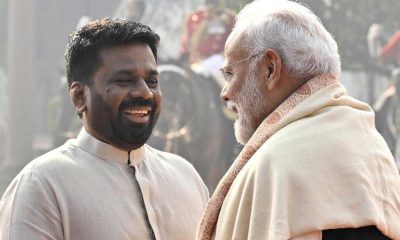
 Features6 days ago
Features6 days agoAKD faces challenging year ahead
-

 Editorial6 days ago
Editorial6 days agoA kiri-kekiri issue
-

 Sports6 days ago
Sports6 days agoSt. Sebastian’s dominate at Bambalapitiya
-
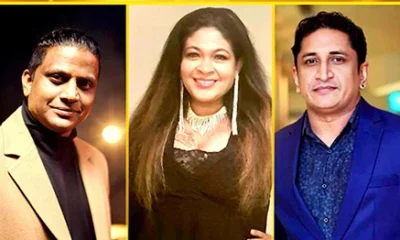
 Features5 days ago
Features5 days agoThey, too, had a ball …Down Under
-
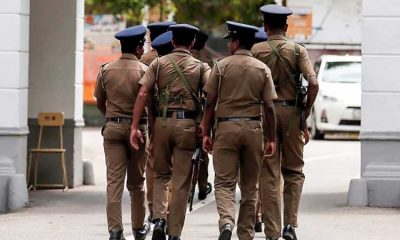
 News3 days ago
News3 days agoReshuffle of senior cops on the cards
-
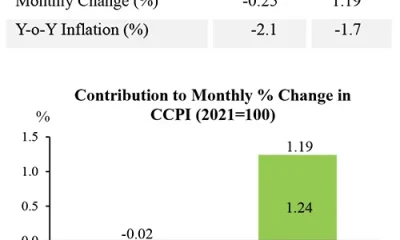
 Business5 days ago
Business5 days agoCCPI-based headline inflation continued to remain in negative territory in December 2024
-

 Editorial4 days ago
Editorial4 days agoBribe-gate and other unsolved plots
-

 Editorial5 days ago
Editorial5 days agoMessages and subtexts












